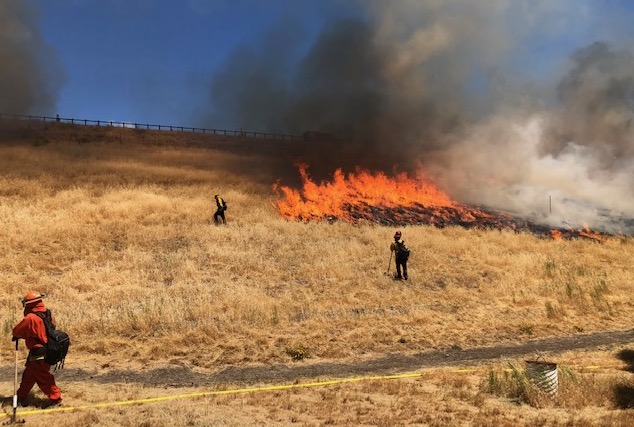
Long insulated from severe risk by mild temperatures and the fog that regularly swaddles the Santa Cruz Mountains, San Mateo County now finds itself — like the rest of the Bay Area — facing the climate-driven prospect of catastrophic wildfire. The threat is leading one of the county’s largest landowners to devote unprecedented resources to fire-prevention efforts in the Peninsula Watershed — efforts that will also restore parts of the landscape to an approximation of their historical condition.
“In the last few years, the weather has changed in regards to the relative humidity,” says Fire Safe San Mateo County’s Denise Enea. “Normally you would go up to [the redwood-forested ridgeline at the edge of the watershed] and it would be kind of cold and misty. Now, you get out of the car and you reach for your sunglasses and your cap because it’s hot and it’s dry. And we’re also seeing much more wind.” The upshot, she says, is a noticeable increase in fire ignitions — including one in mid-May, much earlier in the year than normally expected. Thousands of homes occupying the area’s wildland-urban interface, including some of the region’s priciest properties, would be at risk in the event of a conflagration.
The changed weather, along with more frequent and extended droughts, is leading the San Francisco Public Utilities Commission (SFPUC), which owns approximately 23,000 acres of the upper watersheds of San Mateo Creek and Pilarcitos Creek, to double down on fire prevention efforts. “Last year we did more wildfire risk reduction work than any previous year,” says SFPUC’s Tim Ramirez, “and this year we’re going to do more than last year. We are removing hazardous trees that have died from drought and plant pathogens, expanding our fuel breaks, and getting at ladder fuels in the understory.”
SFPUC is also working with Cal Fire on a new project that would allow the state agency to conduct additional prescribed burns in certain areas of the watershed. Traditionally Cal Fire conducts prescribed burns on San Andreas and Pilarcitos Dams (seven acres total); this year both were conducted on June 9.
Ramirez notes that the heavy tree cover that blankets the watershed’s slopes is relatively new; before settlers arrived and began planting trees — many of them not native — on their farms and ranches, the area was largely grassland. To help guide its vegetation work, the SFPUC has commissioned a historical ecology report from the San Francisco Estuary Institute. “It gives us a bit of a glimpse of what the area used to look like,” says Ramirez, adding that the intent is not to recreate the past entirely. “But it helps us try to restore the biodiversity of the watershed at the same time we’re reducing some of the fuel loading and wildfire risk. We’re going to restore some of these grasslands and manage them that way in the future, not let the trees just come back.” The report is expected to be completed later this summer.
The SFPUC’s work is concentrated along its property boundaries and roadways, including the ridgeline next to Highway 35, which is also where, in May, the Commission approved a six-mile extension of the Bay Area Ridge Trail. “The ridgeline that runs through the watershed lands is a key connection for the Ridge Trail,” says Liz Westbrook of the Bay Area Ridge Trail Council. “We’ve been working on it with the SFPUC for more than 20 years.”
Although new public access to the watershed lands carries some risk — a careless hiker’s smoldering cigarette butt could ignite a fire, for example — Ramirez says that overall, the new trail will help protect the watershed. “It’s going to give us access to places we haven’t been able to get to before for emergency response.” He also notes that the docents who will patrol the trail, and the trail users themselves, can help spot and report small fires before they become big ones.
The SFPUC funds and conducts its own work on the Peninsula Watershed, and also supports and coordinates with other agencies, including Cal Fire; local fire protection districts; the Mid-Peninsula Open Space District, which has extensive holdings adjacent to the watershed; and Fire Safe SMC. Governor Newsom’s state budget for the year includes $2 billion for wildfire prevention; roughly half of it will be dedicated to vegetation management, including grants for local agencies to conduct forest health projects.
Prior Estuary News Story
A Century of First Responders, December 2020
Top photo: Recent prescribed burn on San Andreas Dam in June 2021. Photo: SFPUC